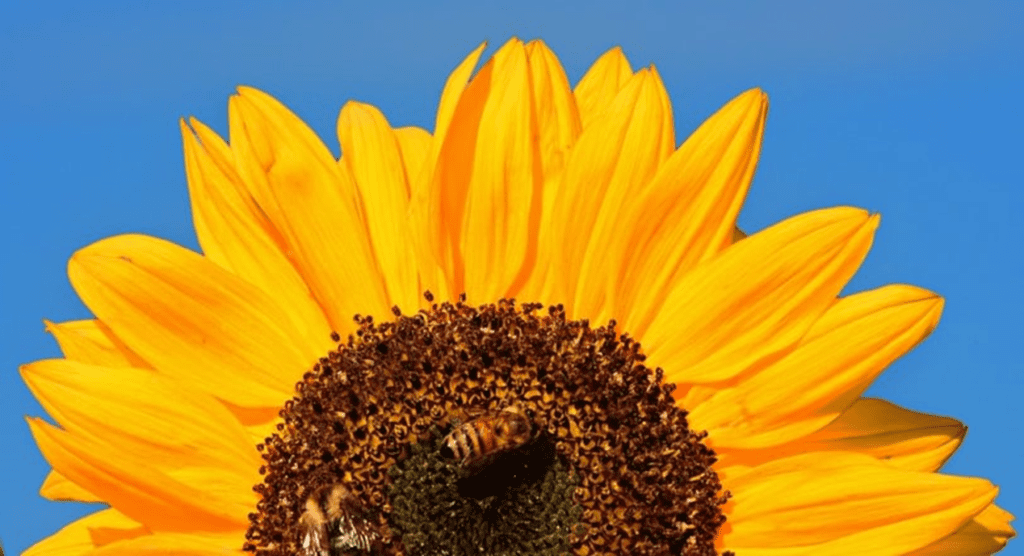This blog contains information about Sunflower. In the start, we introduces sunflower in detail. Then we explain the Heliotropic behavior of Sunflower. After that we discuss the Anatomy of Sunflower. Then we studied about the time of the year when sunflower bloom. It also explains the Biological Benefits of Sunflower in detail. Then we explain the Growth stages of Sunflower. In the end, we discuss the Commercial and Industrial uses of Sunflower in detail. This blog contains bloom and growth stages of Sunflower.
Introduction to Sunflower:
Common Sunflower Helianthus annuus is a specie of large forb of the daisy family Asteraceae. Sunflower is harvested for its edible oily seeds for the production of cooking oil.
Sunflower has an erect rough-hairy stem with the typical height of 3 meters or 10 feet so the tallest sunflower recorded on Earth is 9.7m or 30 feet.
The most interesting fact about sunflower is that, it tracks the sun in the sky and moves with the movement of the sun for capturing sunlight. This makes sunflower more developed and initiate more fine growth and quality as compared to other plants and flowers. It takes maximum sunlight throughout the day as it moves with the sun. This makes it a rich productive flower and provide us cooking oil. It is also used in many commercial and industrial purposes.
Heliotropism in Sunflower:
Sunflower is famous because it shows heliotropic nature. Heliotropism means that the young bud of sunflower faces east in the morning and follow the movement of sun as it changes its position throughout the day. This is the most special phenomenon and distinct feature of sunflower so this feature effectively help sunflower to absorb maximum sunlight and maximum energy from the sun.
Anatomy of Sunflower:
Sunflowers are composite flowers. Although the large flower head at the top of the plant is often thought to be the flower, it is in fact hundreds of small flowers. The male (stamen) and female (stigma) are both present in disk flowers. The stamen is composed of filament and pollen-producing anthers. The stigma houses the style, which receives the pollen and allows it to travel down to the ovary, where the unfertilized seeds, i.e. the ovules, are located. This process of pollination enables the flowers to produce seeds.
The yellow petals on the outer circle of the sunflower head are in fact not petals but each is an individual ‘ray flower’. Ray flowers serve to attract pollinators to the ‘disk flowers’. The disk flowers are those tiny buds in the middle of the sunflower head. In this way sunflower blooms.
When Sunflower blooms?
The blooming season for sunflower is Summer and into Autumn. Sunflower blooms in extreme sunlight because its energy and production completely rely on sunlight. It captures a lot of heat to produce cooking oil. Its planting and growth gives best result during the hot season and high temperatures.

Biological Benefits of Sunflower:
Following are some of the Biological Benefits of Sunflower:
Cardiovascular Diseases:
Sunflower seeds help us to reduce the risks of cardiovascular diseases in humans. These diseases includes high cholesterol, high blood pressure etc. so the people who use sunflower seed oil are less prone to risks of getting cardiovascular diseases and help us to maintain your cardiovascular system health.
Help to improve your Immunity:
Sunflower can work in maintaining and improving your immunity and help to increase your strength to fight against the diseases and infections that attacks the body. Immunity is the power of our body to fight against all the negative energies that attacks our body so Sunflower has the ability to improve our immune system to make it work in a better way.
Reduce Inflammation:
For those with short-term or chronic inflammation, sunflower seeds can offer anti-inflammatory benefits. Sunflower seeds contain vitamin E, flavonoids, and other plant compounds that can reduce inflammation. A study found that consuming sunflower seeds and other seeds five times or more each week resulted in lower levels of inflammation, which also lowered risk factors for several chronic diseases.
Improve overall Heart Health:
Sunflower and sunflower seeds helps in improving your heart health. It means that it regulates your blood flow throughout your body. This helps in maintaining the heart health of any patient. It helps in improving the functioning of your heart so the people who use sunflower related eatables and oils will have improved heart health.
These are some biological benefits of Sunflower. This blog contains bloom, growth and stages of Sunflower.
Stages of Growth of Sunflower:
There are following stages of growth of sunflower:
It requires 11 days from planting to emergence.
Then it takes 33 days from emergence to formation of sunflower head.
After 27 days the first anther will appear.
The last anther will appear about 8 days later.
Sunflower develop in this manner. It take 30 days from appearance of the last anther to maturity.
Commercial and Industrial Uses of Sunflower:
Following are the commercial uses of Sunflower:
Sunflower oil cake is used for stock and poultry feeding.
We can use sunflower oil in soaps and so as in paints as a lubricant.
Sunflower seeds can be eaten dried, roasted or ground into nut butter and are common in birdseed mixes.
We can make our conventional cooking oils from sunflower seeds.
Sunflower oil is used in food and so many industrial applications where high levels of monosaturated fats are required.
Its oil is highly stable for frying purposes.
All of these are industrial and commercial uses of Sunflower. Sunflowers provides us many commercial and industrial applications and is a useful flower as a whole. This blog contains bloom, growth and stages of Sunflower.

To learn about more topics, click the links below:


Comments